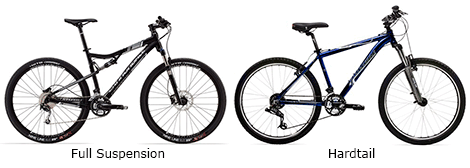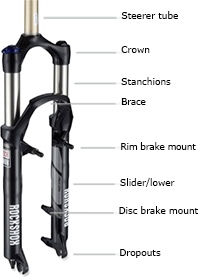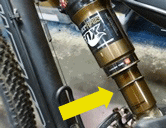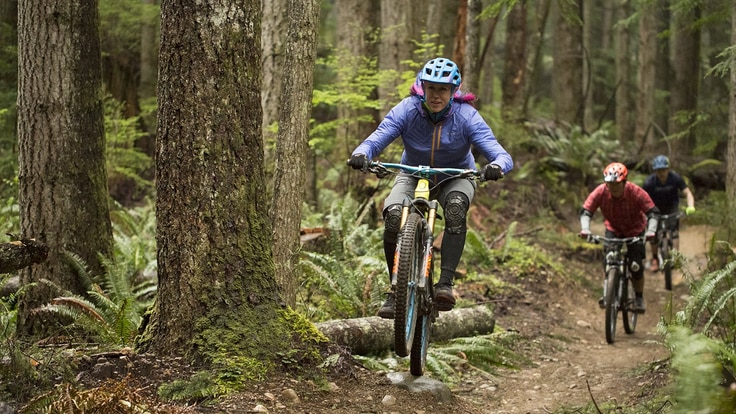Bike suspension provides improved control, traction and comfort on rooty, rocky singletrack or potholed roads. It is one of many factors that contribute to your riding enjoyment.
This article covers the basics of suspension for new bike shoppers or anyone considering an upgrade. We then go on to provide a more detailed look at how suspension works.
Full Suspension or Hardtail?
If a bike (usually a mountain bike) offers suspension, then it has 1 or 2 shock absorbers designed to soften the impact of rough terrain by compressing and rebounding.
Buying a new mountain bike? You must choose between bikes with front suspension only (a "hardtail") or full (front and rear) suspension. Some points of comparison:

| Full Suspension | Hardtail | |
| Upfront cost | Higher | Lower |
| Maintenance cost | Higher | Lower |
| Weight | A bit heavier | A bit lighter |
| Trail suitability | Rougher trails with roots, rocks and drops | Doubletrack, smoother singletrack, pavement, fire roads |
| Best for | Hard rides on rough trails; riders with back or joint issues; rough, high-speed descents | All-purpose use (trail and pavement); efficient hill climbing; relatively smooth trails |
Note: Bicycle manufacturers don't make their own suspension products. Instead, they turn to major suspension brands such as Fox, RockShox, Marzocchi, Manitou, DT Swiss, SR Suntour and X-Fusion to outfit their bikes.
Upgrading Your Suspension
If your current front suspension needs replacing due to non-serviceable wear or damage, you need to know these 4 specs to replace it:
- Axle compatibility: Does your front wheel have a standard 9mm quick-release? Or a 15mm or 20mm through axle? Choose the correct axle dropout size for your wheel.
- Travel: Many bike frames are designed to work with a suspension fork featuring a specific amount of travel. The amount of travel will change the handling characteristics of the bike. An older mountain bike may have an 80mm fork, which is hard to find now. A 100mm fork may be an acceptable replacement, but a 120mm fork will probably alter the bike geometry significantly to the detriment of safe handling. In addition, some fully rigid bikes come with the correct frame geometry angle to upgrade to a suspension fork. Always check with your bike manufacturer for replacement fork recommendations.
- Steerer tube: A standard steerer tube (see components diagram, below) is straight with a 1-1/8" diameter. Very old bikes may have a 1" diameter tube; newer bikes may have a tapered or oversized steerer tube. Make sure your new fork has a compatible steerer tube.
- Brake type: Most mountain bikes now have disc brakes. If you want to replace a fork that has rim brake mounts, your choices will be limited to some very basic suspension models unless you upgrade your wheel and brakes as well.
Paying for Performance
Buying a new bike? Suspension quality has a major impact on its price. Replacing your existing fork? You'll find a range of options and prices. Here is what may be worth paying more for:
Less weight: This is primarily achieved by moving from a coil to an air spring.
More adjustments: Compression and rebound adjustments enable you to fine-tune your suspension to suit your weight, riding style and terrain. Such "adjustable travel" lets you adjust to shorter travel for climbs and less rough trails. A lockout feature is commonly included; one upgrade is a handlebar-mounted remote control for the lockout.
Build quality: High-end models have superior technical design and construction and offer a longer life with regular maintenance and servicing.
Ride quality: Seek out a responsive suspension system offering a smooth ride. How will you know? Comparing prices is a pretty reliable guide. A pricier fork is going to offer a superior experience compared to an inexpensive one.
Front Suspension Explained
Almost all mountain bikes are equipped with front suspension, as well as some hybrid or "comfort" bikes and kids' bikes. Differences:
- Suspension on mountain bikes offers a range of adjustments to fine-tune the riding experience. Variations include the type, amount of travel, robustness and method of bump absorption, as well as the adjustments that can be made.
- Suspension on hybrid and kids' bikes offers basic functionality with minimal or no adjustment.
Types of Suspension
The most common type of front suspension is the "fork." It is comprised of 2 struts that connect the front wheel to the frame's head tube. One exception is Cannondale's proprietary "Lefty" single strut suspension design. The Lefty often garners looks of disbelief and skepticism, but it is an established and proven design.
Components

Steerer tube: connects the fork to the frame.
Crown: connects the 2 stanchions together.
Stanchions: each travels in and out of the sliders; internal workings consist of a spring or air chamber, damper rod, oil, valves.
Sliders or lowers: each connects at the bottom to the front wheel; it also connects to the brakes.
Brake mounts: for rim, disc or both.
Dropouts: to hold the wheel axle.
Travel
This refers to the amount of distance the suspension will move before it is fully compressed. Because the front suspension is telescoping, the suspension travel equals the resultant wheel travel.
Travel Distance
| Inches | Millimeters | Type of Bike |
| 1 - 2 | 30 - 50 | 20" and 24" kids' bikes |
| 2 - 3 | 60 - 80 | 24" kids' bikes, hybrid bikes |
| 4 - 5 | 100 - 120 | "Cross country" and "trail" mountain bikes |
| 5 - 6 | 120 - 160 | "All mountain" mountain bikes |
| 7 - 8 | 180 - 200 | "Freeride" and "downhill" mountain bikes |
Suspension may be referred to as short or long travel:
- Short-travel suspension (less than 120mm) suspension provides all-round riding performance with an emphasis on smooth trails and going uphill.
- Long-travel suspension (greater than 120mm) is best for descending rough terrain at high speeds with greater control. The longer the front travel, the stronger the emphasis is toward descending.
Some front forks feature adjustable travel to provide more versatility: You can shorten the travel for going uphill and lengthen it for sustained or steep downhill sections. Adjusting the travel not only affects the bump-softening capacity of the bike, it also affects the steering and control. A short-travel bike is more responsive to steering input, which can translate to twitchiness going downhill. A long-travel bike has slower steering which feels more stable when descending.
Stanchion Diameter
An ideal fork absorbs impacts vertically without undue lateral flex which can detract from the steering and control of a bike. The diameter of the stanchion tubes affects this lateral stiffness. A narrow tube will flex more under the same force than a wider tube. Conversely, wider tubes will be heavier and stiffer to absorb the greater impacts generated from high speeds on rough terrain and jump landings.
Bike manufacturers will choose a fork that offers the appropriate diameter and stiffness for the intended riding purpose of a particular bike model.
| Type of Bike | Stanchion Tube Diameter (mm) |
| Kids' | 28 |
| Hybrid | 30 |
| Cross country (XC) and Trail | 32 |
| All mountain | 34-36 |
| Free ride and downhill | 38-40 |
Spring System
Two common methods used by a fork to absorb impact and then rebound back:
A coil spring (wound steel coil) provides a linear compression rate, giving smooth, consistent impact absorption over the range of spring travel. Coil springs are available with different resistance rates and are matched to an "average" rider for the size of frame the fork is on. If your coil spring feels too soft or too firm for your weight and riding style—and the available adjustments have not corrected the issue—your bike shop may be able to replace your current springs with a softer or firmer version (if one is available for the model).
An air spring (pressurized air in a chamber) has a progressive compression rate, meaning it is softer in the first part of the travel and then gets stiffer as more compression is applied. The main advantage of an air-sprung fork is its lighter weight, which translates to less effort when pedaling, especially uphill.
| Coil Spring | Air Spring | |
| Performance | Good to very good | Very good |
| Adjustments | Less | More |
| Reliability | Excellent | Very good |
Material selection, design and manufacturing quality all contribute to a fork's performance. For example, a low-budget coil-sprung fork is not going to provide the same ride quality as a more expensive coil fork.
Fork Adjustments
A fork may offer no adjustability, or it may have one or more knobs and dials to tweak.

Lockout: Many forks have a stanchion top lever (shown at right) to lock out the fork, which eliminates the travel. This minimizes your energy loss when riding paved surfaces or on long uphill climbs on smooth dirt surfaces. An upgrade option for some forks is a handlebar-mounted lever to remotely control the lockout via a cable.
Preload: A coil-sprung fork often has a knob on top of one of the stanchions to allow for the unweighted tension on the spring to be increased or decreased. Increase the preload if the fork feels too spongy.
Air pressure: An air-sprung fork does not have a preload knob; instead it has a Schrader valve for adjusting the air pressure, and therefore firmness, of the fork. A special "shock pump" is needed for this; do not use a regular tire pump. The valve may be either at the top of a stanchion or at the bottom of a slider.
Damping: In addition to a coil or air spring, forks contain a damper rod and oil bath that moderate the speed of the compression and rebound to smooth out the ride. Adjustments may be available for both the compression and rebound. Adjusting damping settings are referred to as "tuning the fork." Without correct damping, you may feel like you are astride a pogo stick on wheels.
- Compression damping controls how quickly the spring absorbs an impact.
- Rebound damping controls the speed at which the fork re-extends after compression. This reduces overly fast bounce-back.
See Basic Suspension Setup later in this article.
Rear Suspension
Rear suspension is only found on full-suspension mountain bikes, and is commonly referred to as the rear shock, or "shock" for short. The shock allows the rear wheel to soak up impacts, helping to keep the tire in contact with the ground, increasing rider control and decreasing rider fatigue.
The rear frame triangle, which holds the rear wheel, will have one or more pivot points to enable the wheel to travel through a range of motion. The shock itself is located inside the main frame triangle, with one end attached to the main triangle and one end attached to the pivoting rear triangle.
Various pivot designs and configurations are available. Each has its pros and cons on how it affects a bike's ride quality. Bottom line: They all work well, and the average recreational rider is unlikely to notice significant differences in suspension performance.
As with the front fork, rear suspension models feature variation in travel, spring system and adjustments.
Stroke travel: This is how much a rear shock compresses. It is comparatively short: 1.5" to 3". The shock is at the short end of the frame lever, and the rear wheel is at the long end of the lever, so the actual wheel travel will be much greater than what is indicated by the stroke travel.
Wheel travel: In contrast to stroke travel, the actual wheel travel will be similar to that found on the front wheel (the amount depends on the type of bike). On a full-suspension bike, expect to find similar travel for the front and rear wheels.
Spring system: This is either coil or air, as per the front suspension. Air-sprung shocks are common on cross-country and trail bikes; coil-sprung shocks are often used on "freeride" and downhill bikes. "All mountain" bikes are in the middle and may feature either style.
Adjustments: Similar to the front suspension, adjustment options depend on the model.
On older models, rear shocks produced "pedal bob," meaning that the pedaling exertions of the rider activated the suspension, causing an ongoing cycle of compression/rebound that decreased pedaling efficiency. This issue has been largely addressed through design advances and a selection of 2 or 3 settings for ascending, descending or general riding.
Basic Suspension Setup
Make sure your suspension is properly adjusted. Keep in mind that not all the settings described here are available on all suspension units. Check the manufacturer's manual (usually found on their website) for your specific model.

Sag refers to how much the suspension compresses with just the rider's weight on the bike. Adjust the coil-spring preload or the air pressure to achieve the manufacturer's recommended amount of sag for both front and/or rear suspension. Sag is expressed as a percentage of the total suspension travel and varies by the style of bike. General guidelines:
| Type of Mountain Bike | Suspension Travel | Recommended Sag* |
| XC race | 80 - 100mm | 15 - 25% |
| Trail, all mountain | 100 - 160mm | 20 - 30% |
| Freeride and downhill | 160 - 200mm | 25 - 35% |
* As a percent of suspension travel
Sag enables the wheel to follow undulations in the ground more effectively, allowing the suspension to extend so that the wheel can drop into depressions in the trail. More sag equals a softer ride.
Rebound damping is the most important damping setting. Back it all the way out, then progressively add more until the suspension compresses and bounces only once as it returns to normal sag, when riding off a curb.
Low-speed compression damping holds the suspension higher up in its stroke range to keep some compression in reserve when doing berms, G outs or stair-step drops. This is also what a platform setting does on rear shocks.
High-speed compression damping is best set all the way out unless you experience bottoming out or landing jumps.
Suspension Maintenance
Anything that moves needs periodic maintenance, and suspension can do a lot of moving.
Our tips:
- Prevent or reduce scratches to the stanchions. If these get nicked from a rock or tool, the rough edge can tear up the dust seal and bushings as it slides past, diminishing the performance and life of the suspension.
- Clean the stanchions after every ride with a soft cloth and mild cleaning solution, flossing around the tube and down to the seal in the top of the lowers.
- Check your owner's manual for any other regular maintenance that can be performed by the owner. Some will recommend a light lube around the dust seal at the top of the sliders.
Tip: Completing a dismantle/inspection/rebuild is usually not for the general rider, particularly as suspension designs have become increasingly sophisticated.
Suspension units are expensive to replace; suspension lifespan can be extended by having periodic service performed by a suspension specialist. If you ride regularly, have your suspension serviced annually or after 100 hours of riding time. Regular service will also prolong the life of your bike frame.
A professional suspension service is also highly recommended whenever you experience the following:
- Excessive oil leak onto the stanchions around the top of the sliders.
- An air-sprung unit not holding air and losing all travel.
- Play or knocking between the stanchions and the lower sliders.
- Any unusual collapse or resistance to normal function.



